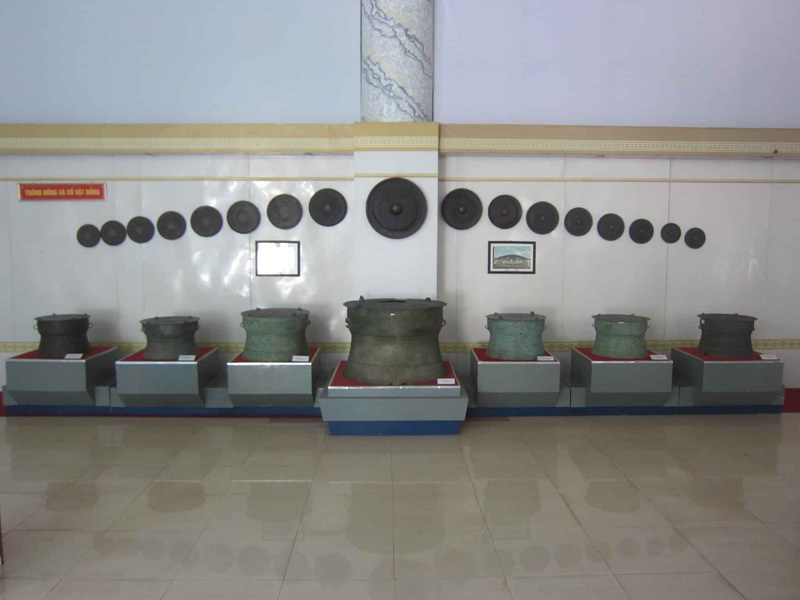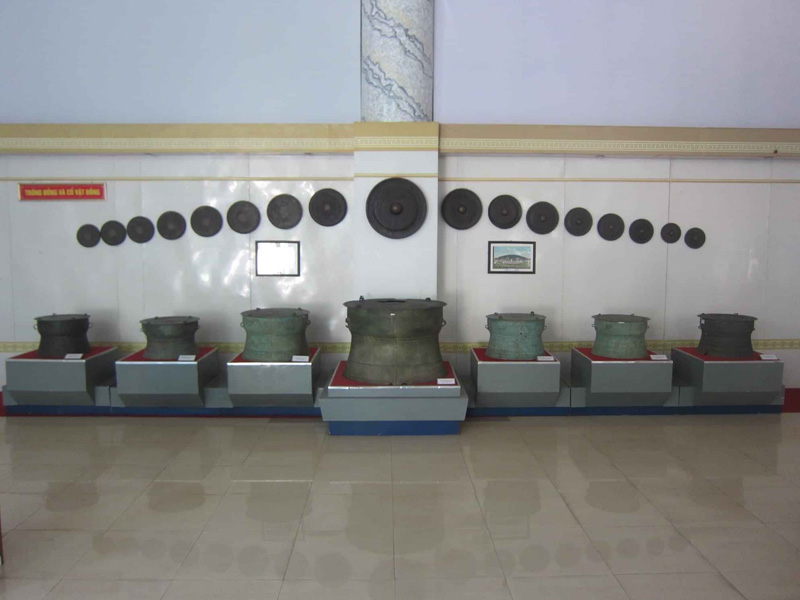
(HBO) - The bronze drum is a valuable asset considered a treasure left by the great grandparents, a symbol of the civilization and culture of Vietnam during the time of national construction. Hoa Binh is the province that has discovered and stored the second largest drums in the country, with two main types, including Heger drum type I(Dong Son drums) and Heger drum type II.
 The bronze drums are displayed at the Provincial Museum.
The bronze drums are displayed at the Provincial Museum.
Bronze drums found in Hoa Binh are mostly Heger bronze drums
type II with different early or late groups. The date of Heger drum type II
lasted from the first to the seventeenth century.
According to the statistics, Hoa Binh province has
discovered over 100 bronze drums, of which the earliest discovered drum was the
Song Da drum (discovered in 1887). This is a Heger drum Type I and a Dong Son
drum of group A type I. This drum is currently stored at the Guimet Museum (in
France).
Ms. Nguyen Thi Thi, Director of the Provincial Museum, says
that the bronze drums type II have been attached to Muong ethnic people for a
long time. They have concentrated in the residence area of Muong ethnic people.
The bronze drum type II is a symbol of the vitality of the Dong Son
civilization, it is also a symbol of confirming the power of Vietnamese feudalism
over Lang Muong areas, demonstrating the political unity of Vietnam - Muong.
Bronze drums are closely associated with Muong ethnic people's life. The bronze
drum type II is a cultural symbol of Muong ethnic people, which is typical for
Muong identity. With the above meanings, Heger bronze drums type II can be
called Muong drums. Currently, 73 bronze drums are kept in the store of the
Provincial Museum, 15 pieces are kept in the warehouse of the People's
Committee of Kim Boi district, the rest is in the archive of some agencies and
localities in the province.
For Muong ethnic people, the bronze drum is a sacred
artifact, symbolizing the power and wealth of Lang class ... The bronze drum is
a friend of the living people, serving the physical and spiritual needs of the
living, and it is also a friend of the the dead and it is also a mourning for
the dead. Bronze drums are found in almost all districts in the province. Apart
from some drums found in ancient Muong tombs, the rest are mainly discovered by
chance when people dig ditches, build houses, build roads ...
If Dong Son drum is a symbol of Vietnamese culture and
civilization, then the bronze drum type II can be considered as a cultural
symbol of Muong ethnic people in Vietnam. The drum has its own beauty, with the
patterns created by the stamp-printing method, especially the fillet pattern,
which has has turned the drum face like a carpet woven with beautiful patterns,
repeating like patterns on the brocade plates of Muong ethnic people in Hoa
Binh.
With an increasingly vibrant and widespread emulation movement aimed at building cultured residential areas and cultured families, Yen Thuy District has been making steady progress toward improving both the material and spiritual well-being of its people, while fostering a civilized, prosperous, beautiful, and progressive community.
Once lacking recreational spaces and community facilities, Residential Group 2 in Quynh Lam Ward (Hoa Binh City) has recently received attention for the construction of a new, spacious, and fully equipped cultural house. The project followed the model of state support combined with public contributions in both labor and funding.
The "All people unite to build cultural life" movement, which has been effectively integrated with Kim Boi district’s socio-economic development goals, is fostering a lively spirit of emulation across local residential areas, hamlets, villages, public agencies, and enterprises. In addition, through the initiative, traditional cultural values are being preserved and promoted, while community solidarity and mutual support in poverty reduction and economic development are being strengthened.
A working delegation of the Hoa Binh provincial People’s Committee led by its Permanent Vice Chairman Nguyen Van Toan on June 11 inspected the progress of a project to build the Mo Muong Cultural Heritage Conservation Space linked to tourism services in Hop Phong commune, Cao Phong district.
Born and growing in the heroic land of Muong Dong, Dinh Thi Kieu Dung, a resident in Bo town of Kim Boi district, in her childhood was nurtured by the sweet lullabies of her grandmother and mother. These melodies deeply imprinted on her soul, becoming an inseparable part of her love for her ethnic group's culture. For over 20 years, this love for her hometown has driven Dung to research, collect, and pass down the cultural values of the Muong people to future generations.
In the final days of May, the Ethnic Art Troupe of Hoa Binh Province organized performances to serve the people in remote, mountainous, and particularly disadvantaged areas within the province. These were not just ordinary artistic shows, but they were the meaningful journeys aimed at spreading cultural values, enhancing the spiritual life of the people and contributing to the preservation of ethnic minority cultural identities.



 The bronze drums are displayed at the Provincial Museum.
The bronze drums are displayed at the Provincial Museum.